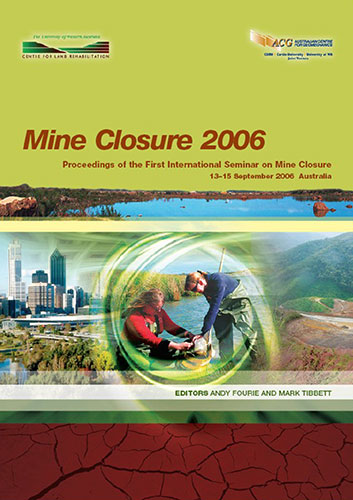Pilbara Iron’s Approach to Sustainable Development During Mine Closure ⎯ The Case Study of Greater Tom Price and Pannawonica Operations

|
Authors: Moller, M; Flugge, R; Murphy, D Paper is not available for download Contact Us |
DOI https://doi.org/10.36487/ACG_repo/605_16
Cite As:
Moller, M, Flugge, R & Murphy, D 2006, 'Pilbara Iron’s Approach to Sustainable Development During Mine Closure ⎯ The Case Study of Greater Tom Price and Pannawonica Operations', in AB Fourie & M Tibbett (eds), Mine Closure 2006: Proceedings of the First International Seminar on Mine Closure, Australian Centre for Geomechanics, Perth, pp. 237-246, https://doi.org/10.36487/ACG_repo/605_16
Abstract:
Pilbara Iron (PI) operates and maintains iron ore mining, rail and export facilities in the Pilbara Region of Western Australia on behalf of Hamersley Iron Pty Limited (Hamersley) and Robe River Iron Associates (Robe). As members of the Rio Tinto Group, PI, Hamersley and Robe operate in accordance with corporate policies and directives. As a part of a sustainable development approach to business and to comply with the revised Rio Tinto Closure Standard (the Standard) (RT, 2004) and associated documentation, PI undertook a series of closure planning studies during 2005 to build on previous closure planning activities previously undertaken over a ten-year period. The objective of these studies was to undertake specific closure planning activities in accordance with the Standard for the eventual closure of PI’s facilities and operations at Tom Price and Mesa J, referred to as the Greater Tom Price and Pannawonica Operations (GTP&PO). The specific intent of the Standard is: “To ensure that Rio Tinto managed activities are left in a condition which minimises adverse impacts on the human and natural environment, and that a legacy remains which makes a positive contribution to sustainable development.” Through implementation of the Standard, Rio Tinto seeks to influence the design, development, operation and closure of all of its operations to ensure the optimisation of post-closure outcomes in terms of environmental, economic and social (EES) development needs and expectations.
References:
RT (2004) Rio Tinto Closure Standard: Version 2.0 June 04.
RT (2004) Rio Tinto Closure Standard – Guidance Note: Draft (V1.0 June 04).
SKM (2005) Tom Price Mine Closure Study 2005.
SKM (2005) Tom Price Town Closure Study 2005.
SKM (2005) Greater Pannawonica Operations Closure Study 2005.
Pilbara Iron’s Approach to Sustainable Development During Mine Closure
― The Case Study of Greater Tom Price and Pannawonica Operations
M. Moller, et al.
246 Mine Closure 2006, Perth, Australia
© Copyright 2025, Australian Centre for Geomechanics (ACG), The University of Western Australia. All rights reserved.
View copyright/legal information
Please direct any queries or error reports to repository-acg@uwa.edu.au
View copyright/legal information
Please direct any queries or error reports to repository-acg@uwa.edu.au